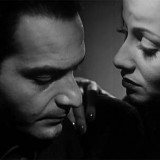Where have you been during winter 1946?
Since some of us would likely say – nowhere, here is a time capsule from that period in Rome, right after WW2 is over. The American GI’s are still in town and the people wake up into the rough realities of making a living in a battered economy.
[youtube width=”615″ height=”461″]http://youtu.be/7k2n7gr7A98[/youtube]
The film is a fine example of a lighter take on the neorealism genre, borrowing from the success of its emblematic predecessor – Roma Citta Aperta by Roberto Rossellini, made a year earlier. In fact, both Marcello Pagliero, the director of this film, and Nando Bruno – both played in Roma Citta Aperta.
 The film uses themes of daily hardships in a much lighter tone, illustrating variety of characters that coincide one rainy night in an intricate plot that moves a pearl necklace from hand to hand.
The film uses themes of daily hardships in a much lighter tone, illustrating variety of characters that coincide one rainy night in an intricate plot that moves a pearl necklace from hand to hand.
From Andrea Checchi, who contemplates suicide over the departure of his treacherous girlfriend (Marisa Merlini), the struggling typist (Valentina Cortese) who can’t pay her rent and opts to street life, the petty thief with a good heart (Nando Bruno). And the dignified minister who lost his memory and keeps asking everyone “do you recognize me?” played beautifully by Vittorio de Sica. Friendships are formed quickly to navigate the criminal elements the night summons. Only at dawn the picture becomes clearer as things are never like they initially seem. That’s where the film extra title comes handy – La Notte Porta Consiglio – The Night Gives Wisdom.
This plot is supported by an endless chain of cigarette-smoking, alcohol/espresso-drinking, you would recognize the theme song composed by maestro Nino Rota. He then reused it in Fellini’s “I Vitelloni.” The music veers from a somber pessimistic flair to a whimsical, comic tone with a promise that no matter what, things will eventually work out fine.
Looking through another prism, with today’s Internet gold rush ignited by twenty something entrepreneurs – this film too was created from nothing by twenty something pioneers with a burning fire to explore the new medium. In fact, this is Pagliero’s first film. It didn’t find major success, but nevertheless it’s a fantastic gem with all the time-specific trappings of people, challenges, culture and Rome before its piazzas were transformed into car garages…

